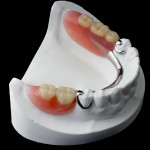
The shortened dental arch (SDA) consisting of ten pairs of occluding anterior and premolar teeth is considered sufficient to provide good oral function. The WHO goal for developing countries of 20 functional, aesthetic natural teeth without resorting to a prosthesis is consistent with the SDA. The aim of this review was compare the functional outcomes of prosthodontic interventions used for treating shortened arches versus un-restored shortened arches in partially dentate adult patients.
Searches were conducted in theMedline, Cochrane Central Register of Controlled Trials, EMBASE, CINAHL, Science Direct, ProQuest, Science Journals, Scopus, PsycINFO, ClinicalTrials.gov, WHO ICTRP, TRIP and PACTR databases. The references of retrieved references were also searched. Only randomised controlled trials (RCTs) and clinical trials (CTs) were considered. Studies describing any prosthodontic intervention used to restore and treat the SDA (removable partial denture prosthesis [RPDP] or fixed denture prosthesis [FDP]) with a control group of patients with a SDA. Study selection and risk of bias assessment was carried out independently by two reviewers. The primary outcomes were patient or operator reported functional outcomes and survival.
- 5 studies (4 RCTs, 1 CT) reported in 21 papers, were included
- A narrative explanation of the pre- specified outcomes is reported.
- The shortened dental arch as a treatment option is encouraging in terms of functioning, patient satisfaction and cost-effectiveness.
The authors concluded
The results from this review related to SDAs as a treatment option were encouraging in terms of functioning, patient satisfaction and cost-effectiveness. However, only the one study reported on the primary outcome of survival of the SDA, and had this been determined by the other studies, it would have strengthened the recommendation of the SDA as a treatment option even further.
Comment
A good deal of detail is provided in the narrative summary of the studies included in this review. This was done because the heterogeneity of the studies and the outcomes reported meant that meta-analysis was not possible. The quality of the available evidence was judges using the GRADE methodology and the best that some outcomes could achieve was moderate quality meaning that, ‘Further research is likely to have an important impact on our confidence in the estimate of effect and may change the estimate.’ Of the 8 outcomes considered, 4 were considered to be moderate the remainder were low or very low. Further high quality studies are needed to confirm these findings and provide answers to the longer-term issues such as survival of the SDA.
We recently reported on one of the studies included in this review (Dental Elf 14th May 2014).
Links
Khan S, Musekiwa A, Chikte UM, Omar R. Differences in functional outcomes for adult patients with prosthodontically-treated and -untreated shortened dental arches: a systematic review. PLoS One. 2014 Jul 3;9(7):e101143. doi: 10.1371/journal.pone.0101143. eCollection 2014. PubMed PMID: 24992473; PubMed Central PMCID: PMC4081502.

[…] Dental Elf 15th Jul 2014 – Review suggests the shortened dental arch may be an acceptable appr… […]